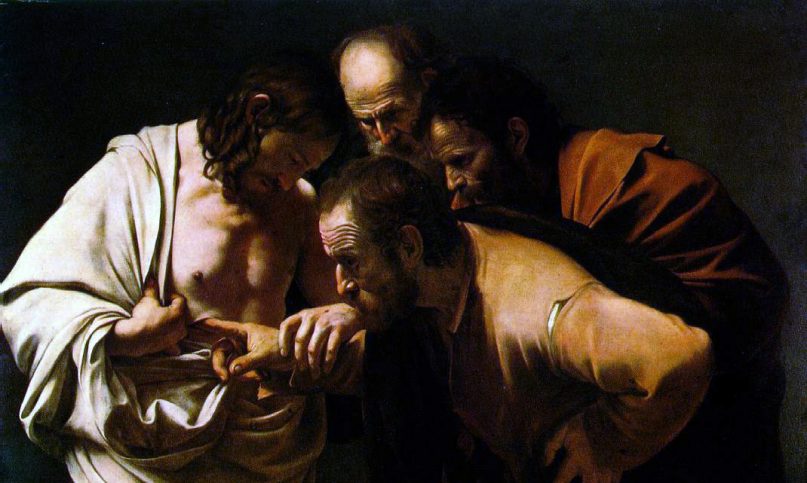The following article is a guest post from Diana Butler Bass
It’s an ancient Christian tradition to retell stories of Jesus appearing to people after the resurrection. Thanks to the lectionary, the story of ‘Doubting Thomas’ was assigned for last Sunday. Though many Christians in American churches revisited this narrative, most missed its point.
You may know the story. Jesus’ disciples are gathered when their resurrected rabbi shows up. But one of the twelve, Thomas, was not present to witness it. When the other disciples recounted the event, Thomas balked: “Unless I see the mark of the nails in his hands, and put my finger in the mark of the nails and my hand in his side, I will not believe.”
A week later the disciples were again in the house, only this time Thomas was with them. The doors were shut and Jesus appeared a second time. He invites Thomas to put his fingers in the wounds, and the doubting disciple exclaims that he now believes.
This story may be familiar to those raised in church. Even if you didn’t grow up in church, it still may be familiar because it is culturally familiar. But in order to let this story fire our hearts anew, we need to see a part of the story many overlook: the beginning.
That very first sentence where John “locates” the story: “It was evening on that day, the first day of the week, and the doors of the house where the disciples had met were locked out of fear.” The disciples returned to their “happy place” where they had felt safe, loved, comfortable. The last place where they had seen Jesus alive. The upper room around the same table where they had shared that last meal. They were cowering with fear in the dining room of that house.
Who among us, when we hear upsetting news, doesn’t seek a familiar place filled with people who can comfort and reassure us?
Though having your dead friend show up for dinner is about the least expected, least familiar thing you can imagine, Jesus did something very familiar, and by the way, very Jewish: He says grace. Jesus offered a new prayer full of deep gratitude: “Peace.”
Now I don’t have much familiarity with dead dinner guests, but I know a thing or two about gratitude. I’ve spent the last fourteen months researching, practicing, and writing about gratitude for my book “Grateful: The Transformative Power of Giving Thanks.” One thing I learned – maybe more than anything else – is that gratitude and tables go together. Even today, in a deeply divided America, slightly more than half of us say grace when we sit at a table to eat.
It’s interesting that the disciples were locked in that dining room. Why? Because they were afraid. And in their fear, Jesus shows up, breathes on them, and speaks “peace.” And just like that, their fear evaporates.
In recent years, neuroscientists have discovered that fear and gratitude don’t exist in the same parts of our brains. Fear resides in the amygdala, the “reptilian” part of our brain. Feelings of gratitude activate our neo-cortex, the front of the brain with our “higher thinking” and more recently evolved capabilities. Indeed, researchers now believe that gratitude and fear cannot exist at the same time – that gratitude actually processes fear, effectively driving fear out, taming it, giving us human beings the possibility of acting with courage, hope, joy, compassion.
So when Jesus shows up at that table on the evening of the empty tomb in the room where a feast had become a funeral, a new table is set. It’s a table of gratitude – the gifts of God for the people of God – with the power to drive out fear.
The second appearance of Jesus is not about “Doubting Thomas.” It isn’t about dogma or the kind of belief that expresses itself in a creed. It is a story of thanks. It’s a story about Jesus showing up–yet again–at the dinner table to cast out fear and transform us into a people of gratitude.
Thomas, of course, doubts because he wasn’t at the meal. He didn’t receive the table blessing, the gift of peace that Jesus brought his grieving friends. Thomas wasn’t a grateful guy. He remembered what was lost. He was probably afraid. He was certainly sad. So, he said, “Can Jesus really be alive?” Thomas was still living in fear, unwilling to enter into a grateful journey toward a new reality. Like his Jewish forefathers, his doubt echoes: “Can God set a table in the wilderness?”
Fun fact: Almost all of the post-resurrection appearances involve eating and food. In the fifty days between the Resurrection and the Ascension, Jesus shows up at meals and at tables, even in some cases, asking for food! And every time he does, there would be a prayer. Because that is what Jews did – said thank you at the beginning and at the end of every meal. Gratitude. Table grace.
All this makes me think we’ve missed something important about Easter. Protestants are often accused of skipped over Good Friday too quickly in an attempt to get to Easter. But I wonder if we skip over Maundy Thursday too fast in our hurry to get to Good Friday. We’ve underplayed Maundy Thursday’s dinner table in favor of Good Friday’s suffering on the cross. What if the main story isn’t the violence of Friday, but the feast of Thursday?
We always read the dinner table from the cross. But what if we read the story the other way and understood the cross through the experience of the table?
What if the story starts on Thursday? The Last Supper is the final meal of the age that is (the age of injustice, oppression, debt and sin) and the First Feast of the “age to come” (the age of God’s reign of peace and justice). We are “passing over” from the rule of Caesar to being the children of God, from the bondage of slavery to the freedom of serving others. The table is set for the new world, we offer grateful prayers, and our exodus is at hand.
But, of course, Caesar doesn’t want this to happen. The religious hypocrites, the authorities who are complicit with Caesar’s reign, don’t want this to happen. The powers of this age want to destroy the table of gratitude, the table set by God. So comes Friday’s execution, Caesar’s violent attempt to destroy the table forever and to keep us enslaved. Not living in grateful wonder, but in perpetual fear.
Jesus is dead. The disciples return to that room to remember and mourn what almost was. But God says, “No more!” God is out of patience with history’s Pharaohs and Caesars and injustice and hunger and oppression and violence and death and the whole thing. And so, Jesus rises. The tomb is empty.
And where does Jesus go? Does he return to Calvary’s hill and point and shout, “Look, the cross!” No. Jesus rises and goes back to the dining room to offer a table of peace with gratitude in perpetuity. And just before the credits roll in the story, gratefulness banishes fear and thanksgiving replaces grief.
What a story! One might even call it “good news.”

Image courtesy of Diana Butler Bass
Diana Butler Bass (Phd, Duke University) is a scholar specializing in American religion and culture. She is the author of 10 critically-acclaimed books, including “Grateful: The Transformative Power of Giving Thanks.“







